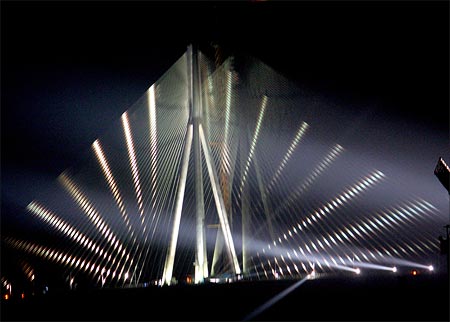
As we approached the toll-booth entrance to the newly completed Bandra Worli Sea Link, the first thing that struck me was the size. It is utterly and unequivocally massive, a man-made mega structure on a scale never before seen in India.
Standing at the Bandra-side entrance, I was barely able to make out where the project ends at Worli Sea Face. It stretches on and on, for kilometres, far off into the horizon. No American bridge I'm familiar with -- from the Brooklyn Bridge to Golden Gate -- compares with this.
It's not just long, either. It's wide, tall and thick. You don't need all the numbers and specs to confirm this. Your eyes don't lie.
The Bandra Worli Sea Link cuts through the formidable Arabian Sea like a warm knife through butter. The towers soar high into the air, like skyscrapers, anchored by dozens of cables, each as thick as a fully grown man's arm.
Looking over the side of the bridge, I could see the gigantic concrete support columns swat away monsoon waves with ease. The menacing sounding Asian Hercules crane -- one of the world's largest -- looked positively dwarfed sitting next to the main bridge.
In short, the BWSL,or the Rajiv Gandhi Setu (as it has now been named) is huge.
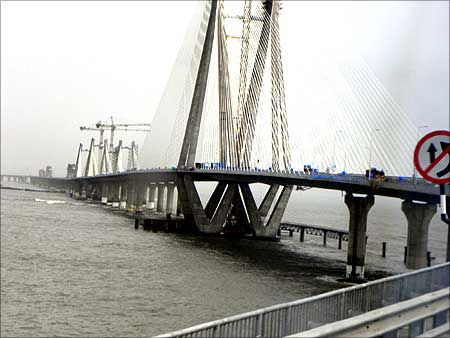
Though the bridge opened for the public on Wednesday, the press was given an opportunity to test it out two days ago. We drove from Bandra to Worli sea face and back in some ten minutes. Amazing. I imagined doing the trip the normal way, which requires languishing at the vicious traffic signal outside St Michael's Church in Mahim, for upwards of fifteen minutes.
Yes, I thought, this is definitely an improvement.
Down below us, a community of fisherfolk set about their work. Some were in their wooden boats, rocking and swaying in the choppy sea. Others helped pull in and sort the haul. Their hutments were extremely modest and their lives looked simple, like a village within a city.
Yet towering above them was a concrete and steel behemoth that, for them, must seem other-worldly, like something out of a science fiction movie.
Meanwhile, some of the city labourers on the bridge, who might otherwise have been down in the fishing village below, beamed with pride and described their work with genuine excitement. That had contributed to a massive step forward for India.
That's when I realised: This is it, warts and all. This is perhaps the first concrete -- no pun intended -- manifestation of India Shining.
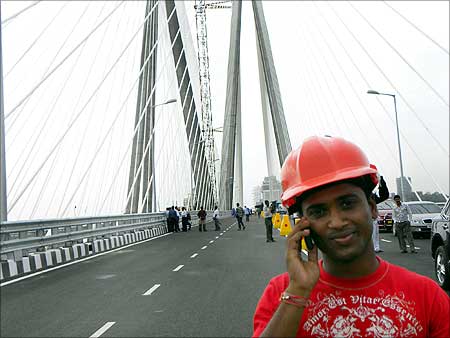
As someone who's been obsessed with this fascinating country for the better part of the past decade, I had read countless stories about 'India Shining'.
I had read about annual growth rates topping 8%. I had read about a glittering democratic system, the world's largest and perhaps most impressive. And in my daily interactions, the Indians I encountered were brilliant. Surgeons, lawyers, engineers, professors and so on. The entire contingent of Indian kids with whom I attended university seemed to nab jobs on Wall Street or in Washington DC.
No country on Earth is better positioned to be a superpower, I proclaimed in 2006. India was the place to be. But, what I didn't fully realise then, is that most of these stories were built on speculation. India was a 'rising' superpower, surely, but it still had a long when to go.
When I finally came here, in early 2007, I didn't see India Shining. I saw India Struggling. Specifically, I saw millions of Mumbaikars struggling to get to office each morning. Every day, like clock work, the local trains were packed well beyond any normal conception of capacity. Regular, routine traffic snarls stretched kilometres. Gridlock turned highways into parking lots. BEST buses threatened to spill their overstuffed contents.
And from my perspective, it all culminated at the Bandra-Mahim causeway, where a two kilometre stretch of road could take forty-five minutes to cross.
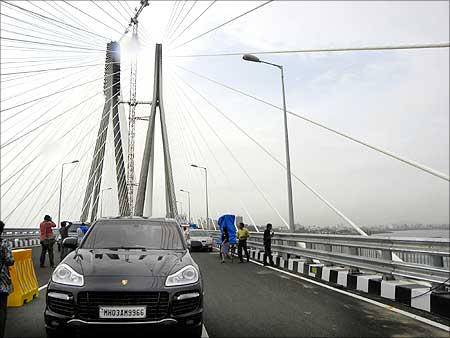
If you think of a city as a giant person, the transportation infrastructure is its circulatory system, and delivers oxygen-rich blood, or in this case workers, to the rest of the body. In Mumbai, this system was so choc-o-bloc with artery-clogging cholesterol, aka traffic and crowds, that one day the whole shebang was going down in massive heart failure. The city needed an angioplasty. Stat.
And that, ostensibly, is what the Bandra Worli Sea Link will provide.
That doesn't mean there aren't disappointments. For one, the preparations on the Worli side seem so ad-hoc and rushed, that it's almost unbelievable.
During the special press opportunity, Mumbai's Joint Commissioner of Police (Traffic) Sanjay Barve gave a brief presentation wherein he laid out the current scenario. As he described how measures to ease traffic at the Worli exit would be implemented in due time, I couldn't help but find this self-assuredness appalling.
How, in a project that's been riddled with delays, did it seem acceptable to say that the applications for a citizen's walkway 'have already been filled out and sent to the government'. Um, quick question: Shouldn't this have been done years ago?
Every query was parried with the same excuse, "These things take time. The applications are filled." Not excusable.
I do believe that if this were America, heads would roll.
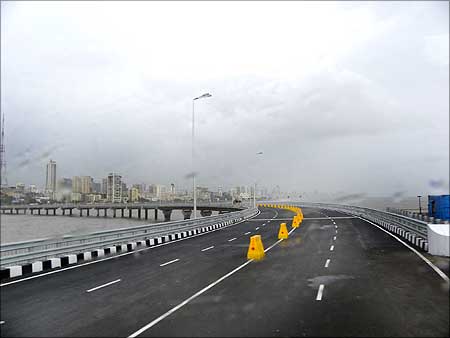
Already my phone is abuzz with calls from friends who live on the Worli sea face, bemoaning the influx of traffic that has nowhere to go. "Traffic is already backed up on the bridge and, despite the police's assurances that only AB road would be used during the morning's peak hours, cars are making U-turns and driving down our lane," one said glumly.
However, my pity for South Mumbai residents certainly has its limits.
For the last two years I've marvelled at Marine Drive beautification projects, the quiet and well-maintained bylanes of Old Cuffe Parade and the charmed Malabar Hill. Compare that with Andheri, where I live, with its crater-sized potholes, lack of proper sidewalks and pathetically insufficient infrastructure. The contrast is jarring.
Suburban Mumbai deserves to have its share of the burden eased.
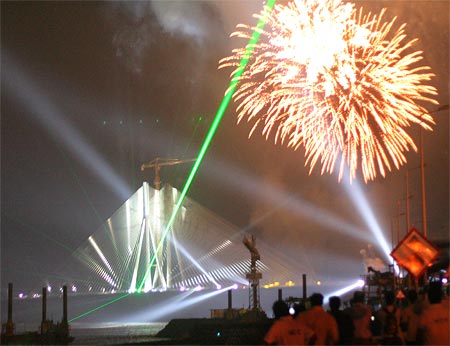
And make no mistake. This is definitely a project for the suburbs. Two nights back, when the government put on a fireworks display on the largest section of the new bridge, thousands of the city's residents came to watch.
From the Mahim causeway, along the Bandra bandstand, Indians of every age and economic background came to watch. Wide-eyed children filled with wonder. Star-gazing lovers on two-wheelers. Full families with elderly members in tow. AR Rahman's Jai Ho blared in the background.
As lasers cut through the foggy night sky and fireworks exploded overhead, the crowd cheered and danced. I found that the onlookers were overwhelmingly from the suburbs. Their excitement was palpable.
This is understandable. Half of India, it seems, is forced to commute to the city's southernmost tip every single day. Any effort to improve this journey will be met with well-deserved glee.
One couple I spoke to came all the way from Kandivali for the display, the husband claiming he would now take the Sea Link 'daily', on his drive to and from Nariman Point.
Conversely, most South Mumbai residents hardly ever leave the comforts of their island. A Malabar Hill-walli once told me, "People should need a visa to drive past Haji Ali Mosque, to keep those surburbanites out of here." When I told her that I live in Andheri, she responded in a single word. "Eww."
For her, and many of her ilk, a trip to Bandra might as well be a trip to Nagpur. So why should they care about the bridge?
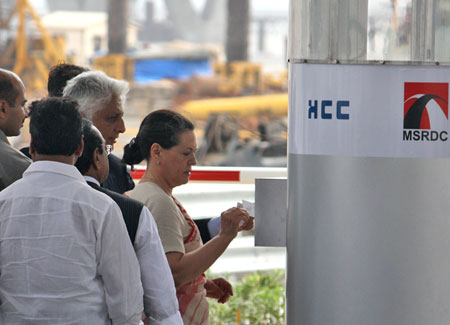
Anyhow, when Sonia Gandhi came to inaugurate the Sea Link yesterday, everyone on hand was the very picture of happiness. Even the normally scowling Mumbai traffic cops were overjoyed, as Soniaji looked on benevolently.
Not only was this a project for the suburbs, this was a project for Maharashtra and by Maharashtra.
For the last year or so, I've heard an idea kicked around by various members of city and state bodies -- that Mumbai needs a gigantic statue of the great warrior-king Chhatrapati Shivaji Maharaj, on the order of America's Statue of Liberty. In a city where people literally starve to death, and where infrastructure woes literally cause people's lives to grind to a halt, I've always found this idea massively flummoxing.
Yes, the Statue of Liberty is a wonderful icon for the city of New York.
But at the turn of the 20th century, what made America great, were the opportunities it provided to its citizens, particularly in the Big Apple itself. Although worldwide the Statue of Liberty is easily recognisable, to New Yorkers the true monuments are those that put function over symbolism: The Brooklyn Bridge. The Subway system. The Empire State Building.
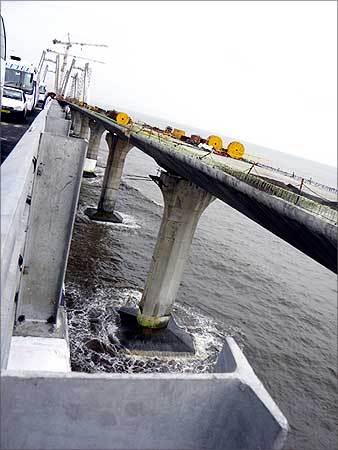
Shivaji has a massive park in Dadar, one of the city's largest and most iconic. Shivaji has the city's most famous railway station. Even the international airport is his.
I hate to put words in the mouth of Maharashtra's favourite son, but I don't think Shivaji really needs or wants a gigantic statue.
Right now, as the drama unfolds in Uttar Pradesh over Chief Minister Mayawati and her multi-crore statues, it seems commonsensical to caution against this kind of wasteful extravagance.
As a Maharashtrian friend told me, "In his heart, every Maratha carries the spirit of Shivaji. We don't need a statue to remind us of that. Shivaji would want Mumbai to be the best possible city for all her citizens. He would want useful public works projects."
In many ways, Mumbai is known as the city that survives in spite of government, thanks to its extreme entrepreneurship and resiliency. Despite a woefully inadequate and often crumbling infrastructure, despite paying an obscene portion of India's taxes (oftentimes to fund restorations of Delhi monuments and mansions), despite a breathtakingly corrupt and uncaring bureaucracy, the city continues to be India's best and brightest. It's still a top ten global finance centre. It's still one of the world's great entertainment hubs. It's still South Asia's City of Dreams.
Now, finally, the people can say that government has given them something back, even if it came with the usual strings attached. Since the days of Independence, someone told me yesterday, the government of Maharashtra has used and abused Mumbai. With the opening of the Bandra Worli Sea Link, we may have witnessed the start of something new.
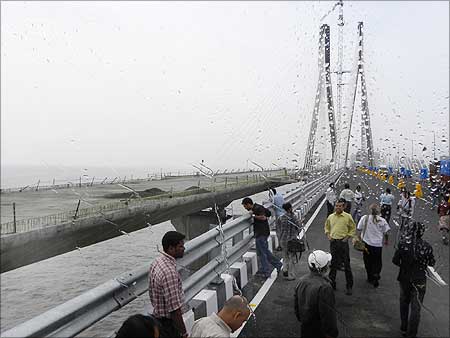
But then I'm forced to consider Mukesh Ambani and his reportedly $2 billion home under construction. His house costs ten times more than India's greatest ever public works? Absurd. It makes me wonder if feudalism still exists, and what the 'India Shining' story really holds in store for all of us.
Couldn't he have built a similar house at half cost, and dedicated the other half to rebuilding the crumbling infrastructure of the city that gave his family fortune?
Oh, well.
What matters now is that the magnificently glittering Bandra Worli Sea Link is open. And although the water that flows beneath its bridges -- freshly spilled from Mahim creek -- is carrying deadly pollutants and harmful bacteria and god-knows-what-else from Dharavi, India really is Shining. Warts and All.